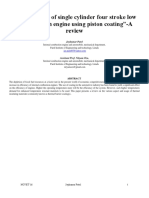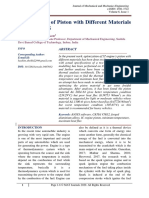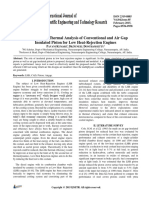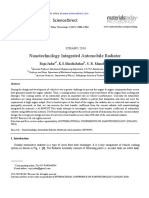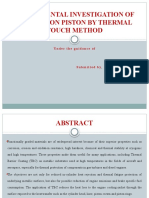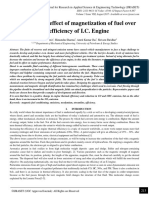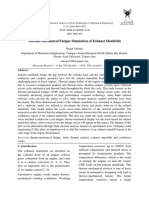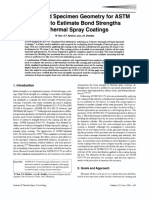A Literature Review On The Performance Analysis of 4 Stroke Diesel Engines With Ceramic Coating Material-36993
A Literature Review On The Performance Analysis of 4 Stroke Diesel Engines With Ceramic Coating Material-36993
Uploaded by
ARUN VCopyright:
Available Formats
A Literature Review On The Performance Analysis of 4 Stroke Diesel Engines With Ceramic Coating Material-36993
A Literature Review On The Performance Analysis of 4 Stroke Diesel Engines With Ceramic Coating Material-36993
Uploaded by
ARUN VOriginal Title
Copyright
Available Formats
Share this document
Did you find this document useful?
Is this content inappropriate?
Copyright:
Available Formats
A Literature Review On The Performance Analysis of 4 Stroke Diesel Engines With Ceramic Coating Material-36993
A Literature Review On The Performance Analysis of 4 Stroke Diesel Engines With Ceramic Coating Material-36993
Uploaded by
ARUN VCopyright:
Available Formats
e-ISSN(O): 2348-4470
Scientific Journal of Impact Factor(SJIF): 3.134
p-ISSN(P): 2348-6406
International Journal of Advance Engineering and Research
Development
Volume 2,Issue 1, January -2015
A LITERATURE REVIEW ON THE PERFORMANCE ANALYSIS OF 4
STROKE DIESEL ENGINES WITH CERAMIC COATING MATERIAL
A. I. PANDEY1
1
Lecturer In Mechanical Engineering Department, R.C.Technical Institute Sola Ahmedabad,
pandeyatul2001@Gmail.Com
Abstract : Today’s the use of diesel fuel is increase in the world. People do not use diesel only for transportation but also
for agriculture and as we know that the lots of heat loss without any use of it. The efficiency of IC Engine is reduced and
fuel consumption is increased. The Lots of research works are carried out to increase the efficien cy of IC Engine and
reduce fuel consumption such as Laser Surface Textured (LST) method, Thermal Barrier Coating (TBC) method. Piston
is the one of the main part of IC engine. The function of piston is transfer the pressure to the crank through the
onnecting rod. Generally piston is made by cast iron and aluminum alloy. As we know that by using of ceramic material
coating on piston, the performance of IC Engine can be increased.
Keywords: Thermal Barrier Coating (TBC), Laser Surface Textured (LST), Ceramic materials
I. INTRODUCTION TO PISTON OF C.I. ENGIN E
As we know that the piston is heart of the C.I. engine. The function of piston is to compress the air during
compression stroke and transmit the gas force to the crank through connecting rod during expa nsion stroke. The piston of
C.I. engines are generally made of cast iron, cast steel and aluminum alloy. The thermal expansion coefficient of piston
made fro m alu minum alloy material is greater than the thermal expansion coefficient of cast iron. When comb ustion of
fuel takes place inside the cylinder into C.I. engine, high heat is generated. 30% of the heat supplied is lost through the
coolant and 30% is wasted against friction and other losses, thus remain ing 30% of heat can be utilize for working
purpose.16 It leads to reduce thermal efficiency and increase the fuel consumptions of C.I. engine. In now days the
demand of diesel engines are increases, people use it for transportation and also in agriculture therefore the environment
becomes mo re polluted. The automobile industries are facing a serious challenge to increase the fuel efficiency and do
hard work to reduce the emission. So many research works are continue on alternate fuel of diesel engine or efficient use
of diesel fuel into diesel engine .There are so many methods are used to improve the efficiency of diesel engine and
reduced fuel consumption. For this purpose one of the technologies is used that is ceramic coated IC engine .It is also
known as Thermal barrier coating (TBC) or lo w heat rejection engine (LHRE).
Fin ite element method (FEM) is widely used in almost all fields of engineering such as thermal, temperature,
flu id flows, structural, pipe and channel flow, dynamics analysis etc. Fin ite element analysis is used for the thermal
analysis of ceramic coated and uncoated piston.
List of methods of coating:
There are different methods of coating. Those are follo wing:
Thermal spray coating: Plasma spray, wire flame spray and powder flame spray, electrical arc spray, detonation
gun technique and high speed oxy fuel system
Chemical ceramic coating: Sole-gel, slurry, chemical vapour sedimentation, physical vapour sedimentation, hard
coating.
Laser coating
Arc spark alloying
Ion enrich ment method
Types of Ceramic materi al:
Yittria Stabilized Zirconia (YSZ)
Partially Stabilized Zirconia (PSZ)
Garnets
Spinel
Mullite
Alumina
@IJAERD-2015, All rights Reserved 1
International Journal of Advance Engineer ing and Research Development (IJAERD)
Volume 2,Issue 1,January -2015, e-ISSN: 2348 - 4470 , print-ISSN:2348-6406
Advantage of Ceramic Coated piston
The basic intent of ceramic coated is to be considerably enhancing the performance of C.I.Engine. When
performance of C.I. engine takes place with ceramic coated piston by experiment and fin ite element analysis, it offers the
following advantages:
Reduction in frict ion
Low cetane fuels can be burnt.
Improvements occur at emissions .
Waste exhaust gases are used to produce useful shaft work,
Increased effective efficiency,
Increased thermal efficiency,
Using lower-quality fuels within a wider distillat ion range,
The ignition delay of the fuel is considerably reduced,
The faster vaporization and the better mixing of the fuel,
Reduced specific fuel consumption,
Multi-Fuel capability,
Improved reliability,
Smaller size,
Lighter weight,
Decreased the heat removed by the cooling system,
The first start of engine on cold days will be easier,
Decreasing knocking and noise caused by combustion
Increase the life of co mponent [18]
Application of ceramic coated piston
IC Engine
Recip rocating air co mpressor
II. LITERATURE S URVEY
[1] Muhammet Cerit, Mehmet Coban “Temperature and thermal stress anal yses of a ceramic-coated alumi num
alloy piston used in a diesel engine” Internati onal Journal of Thermal Sciences , Volume 77, March 2014
The goal of this paper is to determine both temperature and thermal stress distributions in a plasma -sprayed magnesia-
stabilized zirconia coating on an alu minu m piston crown to imp rove the performance of a diesel engine. Effects of the
coating thickness on temperature and thermal stress distributions are investigated, including comparisons with results
fro m an uncoated piston by means of the finite element method. Temperature and thermal stress analyses are performed
for various coating thicknesses from 0.2 to 1.6 mm excluding the bond coat layer. Temperature at the coated surface is
significantly higher than that of the uncoated piston. It is observed that the coating surface temperature increases with
coating thickness by decreasing rate. Increase in the maximu m temperature according to the uncoated piston is 64.3% for
1.0 mm thick coating. The higher combustion chamber temperature provided by means of coating results in the better
thermal efficiency of the engine
[2] Hel misyah Ahmad Jalaludin , Shahrir Abdull ah, Mariyam Jameelah Ghazali, Bulan Abdull ah, Nik Rosli
Abdullah “ Experi mental Study of Ceramic Coated Piston Crown for Compressed Natural Gas Direct Injecti on
Engines” INTERNATIONAL TRIB OLOGY CONFER ENCE MALAYS IA 2013 Volume 68, 2013
In this paper it is observed that the YPSZ(Yttria Part ially Stabilized Zirconia )/NiCrA l coated CNGDI piston crown
experienced the least heat fluxes than the uncoated piston crowns and the coated CamPro piston crown, giving extra
protection during combustion operation.
[3] Muhammet Cerit “ Thermo mechanical analysis of a partially ceramic coated piston used in an S I engine”
Surface and Coatings Technolog y Volume 205, Issue 11, 25 February 2011
It is observed that the coating surface temperature increase with increasing the thickness in a decreasing rate. Surface
temperature of the piston with 0.4 mm coating thickness was increased up to 82 °C. The normal stress on the coated
surface decreases with coating thickness, up to approximately 1 mm for wh ich the value of stress is the minimu m.
However, it rises when coating thickness exceeds 1 mm. As for bond coat surface, increasing coating thickness, the
normal stress decreases steadily and the maximu m shear stress rises in a decreasing rat e. The optimu m coating thickness
was found to be near 1 mm under the given conditions.
[4] O.P. Singh , Yogesh Umbarkar, T. Sreeni vasulu, E. Vetri vendan, M. Kannan, Y.R. Babu “Piston seizure
@IJAERD-2015, All rights Reserved 2
International Journal of Advance Engineer ing and Research Development (IJAERD)
Volume 2,Issue 1,January -2015, e-ISSN: 2348 - 4470 , print-ISSN:2348-6406
investigation: Experiments, modeling and future challenges” Engineering Failure Analysis Volume 28, March
2013
This paper presents, the results suggest that high operating temperatures and significant reduction in thin film lubricat ion
clearances accelerate the seizure failures. Further tests were conducted with coated piston to mit igate the high
temperature effects. Future directions and challenges in terms modeling such complicated physics have been discussed.
The authors believe that there exists a theoretical gap in modeling the seizure physics and hence, advanced theories
should be developed to enhance the understanding of this complex seizure mechanism.
[5] M. Cerit, V. Ayhan, A. Parlak, H. Yas ar “Thermal analysis of a partiall y ceramic coated piston: Effect on
col d start HC emission in a s park ignition engine” Applied Thermal Engineering Volume 31, Issues 2–3, February
2011
This paper shows that the Effect of partially thermal barrier coating on piston temperature distribution and cold start HC
emissions of a spark ignition (SI) engine are investigated numerically and experimentally. A Thermal analysis was
performed for both standard and coated pistons by using a commercial code, namely ANSYS. The engine tests were
conducted on a single cylinder, water cooled SI engine for both standard and coated cases. Analysis results show that the
surface temperature of the coated piston part was increased up to 100 °C, wh ich leads to an increase in air–fuel mixture
temperature in the crevice and wall quenching regions. Thus, cold start HC emissions considerably decrease compared to
the standard engine without any degradation in engine performance. Maximu m decrease in HC emissions was 43.2%
compared to the standard engine.
[6] Ekrem Buyukkaya, Muhammet Cerit “ Thermal anal ysis of a ceramic coating diesel engine piston using 3 -D
finite element method” Surface and Coatings Technology Volume 202, Issue 2, 25 November 2007
The study of this paper, it is find that firstly thermal analyses are investigated on a conventional (uncoated) diesel piston ,
made of alu minum silicon alloy and steel. Secondly, thermal analyses are performed on pistons , coated with MgO–ZrO2
material by means of using a co mmercial code, namely ANSYS. Finally, the results of four d ifferent pistons are
compared with each other. The effects of coatings on the thermal behaviors of the pistons are investigated. It has been
shown that the maximu m surface temperature o f the coated piston with material wh ich has low thermal conductivity is
improved appro ximately 48% for the AlSi alloy and 35% for the steel.
Fig 1Thermal barrier coating thickness.
The zirconia-based ceramic coatings are used as thermal barrier coatings owing to their low conductivity and their
relatively high coefficients of thermal expansion, which reduce the detrimental interfacial stresses. Material properties of
the MgZrO3, NiCrA l and piston material made of AlSi alloy. Piston is coated with a 350 μm thickness of MgZrO3 over a
150 μm thickness of NiCrA l bond coat (Fig. 1).
@IJAERD-2015, All rights Reserved 3
International Journal of Advance Engineer ing and Research Development (IJAERD)
Volume 2,Issue 1,January -2015, e-ISSN: 2348 - 4470 , print-ISSN:2348-6406
[7] Hanbey Hazar “Characterization of MoN coatings for pistons in a diesel engine” Materials & Design Volume
31, Issue 1, January 2010
In this study, the surface of a piston in a d iesel engine was coated with mo lybdenum nitride (Mo N) by using the arc PVD
method, and its surface behavior was subsequently analyzed. Analyses of micro hardness, SEM, X -ray and surface
roughness were carried out in order to examine surface characteristics of pistons. It is found that the hardness of coated
piston is 2000 ± 400 HV wh ile hardness uncoated piston 123 HV. The results show less deformation and fewer scratches
due to wear on the MoN-coated piston as compared to uncoated one.
[8] Ekrem Buyukkaya “ Thermal analysis of functi onally graded coating AlSi alloy and steel pistons” Volume 202,
Issue 16 15 May 2008
Functionally graded coatings are coating systems used to increase performances of high temperature components in
diesel engines. These coatings consist of a transition from the metallic bond layer to cermet and fro m cermet to the
ceramic layer. In this study, thermal behavior of functional graded coatings on AlSi and steel piston materials was
investigated by means of using a commercial code, namely ANSYS. Thermal analyses were employed to deposit
metallic, cermet and ceramic powders such as NiCrAl, NiCrA l + MgZrO3 and MgZrO3 on the substrate. The numerical
results of AlSi and steel pistons are compared with each other. It was sho wn that the maximu m surface temperature of
the functional graded coating AlSi alloy and steel pistons was increased by 28% and 17%, respectively.
[9] Ravindra Prasad, N.K. S amria “ Transient heat transfer analysis in an internal combustion engine piston”
Computers & Structures Volume 34, Issue 5, 1990
In this paper, the isothermic d istribution in the piston body and heat flow rates to cooling water and air below the piston
at four different engine loads are depicted for cases both with and without insulation coating. The results indicate a 6%
reduction in heat loss through the piston with the use of an insulatio n coating on the cylinder wall.
[10] Selman Aydı n , Cenk Sayın “ Impact of thermal barrier coating application on the combustion, performance
and emissions of a diesel engine fueled wi th waste cooking oil bi odiesel–diesel blends” Fuel Volume 136, 15
November 2014
Finally, the same engine out parameters were obtained and compared with those of uncoated engine parameters in order
to find out how this modificat ion would change the combustion, performance and emission parameters. Results sh owed
that the modification of the engine with coating process resulted in better performance, especially in considerably lower
brake specific fuel consumption (Bsfc) values. Besides, emissions of the engine were lowered both through coating
process and biodiesel usage excluding the nitrogen oxides (NOx) emission. In addition, the results of the coated engine
are better than the uncoated one in terms of cy linder gas pressure, heat release rate (HRR) and heat release (HR).
[11] I. Taymaz, , K. Çakır, A. Mi maroglu “ Experi mental study of effecti ve efficiency in a ceramic coated diesel
engine” Surface and Coatings Technolog y Volume 200, Issues 1–4, 1 October 2005
The combustion chamber surfaces (cylinder head, valves and piston crown faces were coated with ceramic materials.
Ceramic layers were made of CaZrO3 and MgZrO3, by using plasma-coating method onto the base of the NiCrAl bond
coat. The ceramic-coated research engine was tested at the same conditions as the standard (without coating) engine. The
results showed a reduction in heat loss to the coolant and an increase in effective efficiency.
[12] Mesut Durat, Murat Kapsiz, Ergun Nart , Ferit Ficici, Adnan Parl ak “The effects of coating materials in
spark ignition engine design” Materi als & Design Volume 36, April 2012
Ceramic coatings provide good thermal barrier p roperties for designers. In the design of adiabatic engines, reducing in -
cylinder heat rejection requires very special thermal barrier coatings on the engine combustion chamber. Part ially,
thermal barrier coating (TBC) on the top surface of the piston in the annulus form is considered as a solution for
unburned HC emission produced by incomplete combustion with respect to crevice volume after SI engines start (the
three-way catalytic converter is not yet activated in the period of first 120 s). Because TBC on the top piston surface
decreases the thermal conductivity and increases the unburned charge oxidation by increasing the temperature in the
flame quenching area near the entrance of the crevice volume between the piston and liner during the compression and
the early part of the expansion strokes.
In this study, a steady-state thermal analysis was performed to evaluate the temperature gradients in the standard and two
different partially stabilized ceramic coated pistons by using Abaqus finite element (FE) software. A sharp increase in the
temperature of the coated area of the piston was observed as a result of FE simu lations. It is concluded that the annulus
Y-PSZ coating may contribute better, as compared to Mg -PSZ, to decrease the cold start and steady state HC emissions
without auto ignition, since the temperature in the area sh ows a local sharp increase.
[13] Ekrem Büyükkaya, Tahsin Engin, Muhammet Cerit “ Effects of thermal barrier coating on g as emissions and
performance of a LHR engine with different injection ti mings and val ve adjustments” Energy Conversion and
@IJAERD-2015, All rights Reserved 4
International Journal of Advance Engineer ing and Research Development (IJAERD)
Volume 2,Issue 1,January -2015, e-ISSN: 2348 - 4470 , print-ISSN:2348-6406
Management Vol ume 47, Issues 9–10, June 2006, Pages 1298–1310
The results showed that 1–8% reduction in brake specific fuel consumption could be achieved by the combined effect of
the thermal barrier coating (TBC) and injection timing.
[14] X.Q.Cao, R. Vassen, D. Stoever “ Ceramic materi als for thermal barrier coatings” Journal of the European
Ceramic Society 24(2004) 1-10
The main objective of this paper is to study about ceramic materials. Ceramics, in contrast to metals, are often more
resistance to oxidation, corrosion and wear, as well as being better thermal insulators. Except yttria stabilized zirconia,
other materials such as lanthanum zirconate and rare earth o xides are also pro mising materials for thermal barrier
coatings.
[15] Ilker Turgut Yil maz, Meti n Gumus, Mehmet Akçay “THERMAL BARRIER COATINGS FOR DIES EL
ENGIN ES” INTERNATIONAL SCIENTIFIC CONFER ENCE 19 – 20 November 2010, GABROVO
It is known that the efficiency of internal co mbustion diesel engines changes %38-42. It is about %60 of the fuel energy
dismissed from co mbustion chamber. To save energy, combustion chamber component are coated with low thermal
conduction materials. In this paper, give an eye to thermal barrier coating and ceramic materials which are used for
making low heat released engines.
[16] Aravi nth P1, Subramanian S P1, Sri Vishnu G2 and Vignesh P3 “COMPARISON OF VARIOUS
THERMAL BARRIER COATINGS ALONG WITH THEIR EFFECTS ON EFFICIENCIES AND FUEL
CONS UMPTION BAS ED ON THE RES ULTS OF EXPERIMENTAL LITERATUR ES” Internati onal Journal of
Mechanical Engineering and Robotics Research India , Vol. 1, No. 3, October 2012
It is well known fact that about 30% of the energy supplied is lost through the coolant and the 30% is wasted through
friction and other losses, thus leaving only 30% of energy utilizat ion for useful p urposes. There have been numerous
research papers in recent years describing the theoretical benefits obtained from the use of ceramic co mponents in
reciprocating engines, but that describes practical results is very limited.
Thermal Barrier Coatings (TBC) in internal co mbustion engine have advantages such as imp roved thermal efficiency and
combustion, reduction in weight by eliminating cooling systems, etc. however, practical problems are faced in
implementing these coatings in internal combustion engines. The problem presently faced in implementing of TBC as
engine cylinder is thermal mis match which mainly occurs due to improper adhesion and difference in thermal expansion
coefficient between bond coat and cylinder materials.TBC must also withstand wear an d tear. The disadvantage of the
TBC method is that NOx emission is increased.
[17] Vikram A. Mistry, Di pak C. Gosai, Dr. H.J. Nag arsheth “ Temperature Distri bution Anal ysis of MgZrO3
Coated and Conventional IC Engine Components using FEM” IJ EDR | Vol ume 2, Issue 2 | ISSN: 2321-9939 |
2014
This paper deals with temperature distribution analysis of the conventional (uncoated) and ceramic material coated IC
engine combustion chamber components. In this study, firstly, thermal analyses are investigated o n a conventional
(uncoated) diesel piston and cylinder head, made of aluminu m silicon alloy and cast iron respectively. Secondly, thermal
analyses are performed on pistons and cylinder head, coated with ceramic material MgZrO3 by means of using a
commercia l code, namely ANSYS. After that, the results of ceramic coated components are compared with conventional
one. The effects of coating on thermal behaviors of co mponents are investigated. In which noted that the maximu m
surface temperature of the coated pis ton and cylinder head is increased about 479.4 0C and 108.6 0C respectively .
[18] Ravikumar T, Kiran K, Ravichandra V Koti, Chetan Appasab Choug ale “Alternati ve Thermal Barrier
Coati ngs for CI Engines -A Research Review” International Journal of Research in Advent Technology, Vol.2,
No.5, May 2014
E-ISSN: 2321-9637
The depletion of supply of fossil fuels and their increased cost has driven the attention towards energy security. The
energy security can be partially achieved by imp roving the efficiency of en ergy producing equipment’s. Diesel fuels can
be used more efficiently in lo w heat rejection engines (LHR), in which the temperature of combustion chamber is
@IJAERD-2015, All rights Reserved 5
International Journal of Advance Engineer ing and Research Development (IJAERD)
Volume 2,Issue 1,January -2015, e-ISSN: 2348 - 4470 , print-ISSN:2348-6406
increased by creating thin layer of ceramics, a thermal barrier. Also the use of thermal barrier coatings (TBCs) to increase
the combustion temperature in diesel engines has been pursued for over 20 years. Increased combustion temperature can
increase the efficiency of the engine, decrease the CO and unburnt Hydrocarbons (UBHC). TBCs have not yet met w ith
wide success in diesel engine applications. To reach the desirable temperature of 850-900°C in the combustion chamber
fro m the current temperature of 350-400°C, a coating with a thickness of order 1mm is required.
Objecti ve of literature review paper
The objectives of literature review paper are:
Increase the thermal efficiency
Increase the mechanical efficiency
Decrease the fuel consumption
Reduction in emission
III. CONCLUS ION
By this literature review, it is conclude that by using of thermal barrier co ating method the efficiency of diesel engine can
be increased, fuel consumption can be reduced, friction losses can be reduced and emission can be reduced except NOx.
IV. FUTUR E SCOPE
The efficiency of diesel engine can be increased by using of TBC method but it is difficult to perform it experimentally.
When ceramic coating is used in IC engine, the different types of practical problems are occur such as thermal mis match
due to improper adhesion and difference in thermal expansion coefficient between bond coa t and piston materials and it
has to withstand with wear and tear. In future try to develop new material or select proper material to a void the above
problem and reduce NOx emission also.
REFERENCES
[1] Muhammet Cerit, Meh met Coban “Temperature and thermal stress analyses of a ceramic -coated aluminu m alloy
piston used in a diesel engine” International Journal of Thermal Sciences , Vo lu me 77, March 2014
[2] Helmisyah Ahmad Jalaludin , Shahrir Abdullah, Mariyam Jameelah Ghazali, Bulan Abdullah, Nik Rosli Abdullah
“Experimental Study of Ceramic Coated Piston Cro wn for Co mpressed Natural Gas Direct Inject ion Engines”
INTERNATIONA L TRIBOLOGY CONFERENCE MALA YSIA 2013 Volu me 68, 2013
[3] Muhammet Cerit “Thermo mechanical analysis of a part ially ceramic coated piston used in an SI engine” Surface
and Coatings Technology Volu me 205, Issue 11, 25 February 2011
[4] O.P. Singh , Yogesh Umbarkar, T. Sreenivasulu, E. Vetrivendan, M. Kannan, Y.R. Babu “Piston seizure
investigation: Experiments, modeling and future challenges” Engineering Failu re Analysis Vo lu me 28, March 2013
[5] M. Cerit, V. Ayhan, A. Parlak, H. Yasar “Thermal analysis of a partially ceramic coated piston: Effect on cold start
HC emission in a spark ignition engine” Applied Thermal Eng ineering Vo lu me 31, Issues 2–3, February 2011
[6] Ekrem Buyukkaya, Muhammet Cerit “Thermal analysis of a ceramic coating diesel engine piston using 3-D finite
element method” Surface and Coatings Technology Volu me 202, Issue 2, 25 November 2007
[7] Hanbey Hazar “Characterization of MoN coatings for pistons in a diesel engine” Materials & Design Volu me 31,
Issue 1, January 2010
[8] Ekrem Buyukkaya “Thermal analysis of functionally graded coating AlSi alloy and steel pistons” Volu me 202, Issue
16 15 May 2008
[9] Ravindra Prasad, N.K. Samria “Transient heat transfer analysis in an internal combustion engine piston” Computers
& Structures Volu me 34, Issue 5, 1990
[10] Selman Aydın , Cenk Say ın “ Impact of thermal barrier coating application on the combustion, performance and
emissions of a diesel engine fueled with waste cooking oil b iodiesel–diesel blends” Fuel Vo lu me 136, 15 November
2014
[11] I. Tay maz, , K. Çakır, A. Mimaroglu “Experimental study of effective efficiency in a ceramic coated diesel engine”
Surface and Coatings Technology Volu me 200, Issues 1–4, 1 October 2005
[12] Mesut Durat, Murat Kapsiz, Ergun Nart , Ferit Ficici, Adnan Parlak “The effects of coating materials in spark
ignition engine design” Materials & Design Volu me 36, April 2012
[13] Ekrem Büyükkaya, Tahsin Engin, Muhammet Cerit “Effects of thermal barrier coating on gas emissions and
performance of a LHR engine with different inject ion timings and valve adjustments” Energy Conversion and
Management Volu me 47, Issues 9–10, June 2006, Pages 1298–1310
[14] X.Q.Cao, R. Vassen, D. Stoever “Ceramic materials for thermal barrier coatings” Journal of the European Ceramic
Society 24(2004) 1-10
[15] Ilker Tu rgut Yilmaz, Met in Gu mus, Mehmet Akçay “Thermal Barrier Coatings for Diesel Engines” International
Scientific Conference 19 – 20 November 2010, Gabrovo
[16] Aravinth P1, Subramanian S P1, Sri Vishnu G2 and Vignesh P3 “Co mparison Of various Thermal Barrier Coatings
along with their effects on Efficiencies and Fuel Consumption based on the results of experimental literatures”
International Journal of Mechanical Engineering and Robotics Research India , Vo l. 1, No. 3, October 2012
@IJAERD-2015, All rights Reserved 6
International Journal of Advance Engineer ing and Research Development (IJAERD)
Volume 2,Issue 1,January -2015, e-ISSN: 2348 - 4470 , print-ISSN:2348-6406
[17] Vikram A. M istry, Dipak C. Gosai, Dr. H.J. Nagarsheth “ Temp erature Distribution Analysis of MgZrO3 Coated
and Conventional IC Eng ine Co mponents using FEM” IJEDR | Vo lu me 2, Issue 2 | ISSN: 2321-9939 | 2014
[18] Raviku mar T, Kiran K, Ravichandra V Koti, Chetan Appasab Chougale “Alternative Thermal Barrier Coatin gs for
CI Eng ines -A Research Review” International Journal of Research in Advent Technology, Vo l.2, No.5, May 2014
E-ISSN: 2321-9637
[19] Murat Ciniv iz, Mustafa Sahir Salman, Eyüb Canl, Hüseyin Köse and Özgür Solmaz “Ceramic Coating Applications
and Research Fields for Internal Co mbustion Engines ”
@IJAERD-2015, All rights Reserved 7
You might also like
- BS en Iso 2063 - 2005Document22 pagesBS en Iso 2063 - 2005CEMRE YAŞLI100% (1)
- A Literature Review On The Performance Analysis of 4 Stroke Diesel Engines With Ceramic Coating Material-36993 PDFDocument7 pagesA Literature Review On The Performance Analysis of 4 Stroke Diesel Engines With Ceramic Coating Material-36993 PDFShiva ShankarNo ratings yet
- Application of Ceramic Coating For Combustion Chamber Equipments of IC Engine: A ReviewDocument5 pagesApplication of Ceramic Coating For Combustion Chamber Equipments of IC Engine: A ReviewRobert MihaiNo ratings yet
- FEA Analysis and Experimental Investigation of The Ceramic Coating On Aluminum PistonDocument14 pagesFEA Analysis and Experimental Investigation of The Ceramic Coating On Aluminum PistonIJRASETPublicationsNo ratings yet
- "Development of Single Cylinder Four Stroke Low Heat Rejection Engine Using Piston Coating"-A ReviewDocument5 pages"Development of Single Cylinder Four Stroke Low Heat Rejection Engine Using Piston Coating"-A Reviewnityam100% (1)
- Design and Structural Analysis of Ceramic Coated Petrol Engine Piston Using Finite Element MethodDocument11 pagesDesign and Structural Analysis of Ceramic Coated Petrol Engine Piston Using Finite Element Methodravi kumar B v ANo ratings yet
- Irjet V4i5285 PDFDocument4 pagesIrjet V4i5285 PDFThiyagarajan TGNo ratings yet
- (1-8) Research Paper - Hashim Sheikh-FormatDocument8 pages(1-8) Research Paper - Hashim Sheikh-FormatAabal SyloNo ratings yet
- 315264ijsetr3997 165Document5 pages315264ijsetr3997 165Vivek JadhavNo ratings yet
- IIPaperDocument11 pagesIIPaperPunit ShindeNo ratings yet
- Nanotechnology Integrated Automobile Radiator: SciencedirectDocument5 pagesNanotechnology Integrated Automobile Radiator: SciencedirectShreyas NairNo ratings yet
- Review On Thermal Barrier Coating in IC Engine: June 2017Document6 pagesReview On Thermal Barrier Coating in IC Engine: June 2017Manoj ,No ratings yet
- Experimental Investigations On The Performance and Emissoin CharacteristicsDocument6 pagesExperimental Investigations On The Performance and Emissoin CharacteristicsIAEME PublicationNo ratings yet
- Experimental Investigation of Coasting On Piston by Thermal Torch MethodDocument31 pagesExperimental Investigation of Coasting On Piston by Thermal Torch MethodĐįñêśh ĎkNo ratings yet
- Experimental Investigation of Laser Surface Texturing On Piston Rings For Reduction of Friction PowerDocument7 pagesExperimental Investigation of Laser Surface Texturing On Piston Rings For Reduction of Friction PowerfuturemukundNo ratings yet
- Design and Analysis of Piston With CompoDocument11 pagesDesign and Analysis of Piston With Compo22145029No ratings yet
- Case Study On Advanced Manufacturing and Quality Control of Compressor BladesDocument5 pagesCase Study On Advanced Manufacturing and Quality Control of Compressor BladesL...nNo ratings yet
- Fea Analysis and Experimental Investigation of Ceramic Coating On Aluminium Piston Material by Plasma Spray CoatingDocument10 pagesFea Analysis and Experimental Investigation of Ceramic Coating On Aluminium Piston Material by Plasma Spray Coatingvikky coolNo ratings yet
- Characterization of Coated Diesel Engine 2015Document19 pagesCharacterization of Coated Diesel Engine 2015M IdreesNo ratings yet
- Performance Evaluation of Alcohol in An Insulated Di Diesel Engine With Various Piston InsertsDocument9 pagesPerformance Evaluation of Alcohol in An Insulated Di Diesel Engine With Various Piston InsertsInternational Journal of Application or Innovation in Engineering & ManagementNo ratings yet
- Thermal and Metrological Studies On Yttria Stabilized Zirconia Thermal Barrier Coatings and A Simulated Model To Co-Relate The FindingsDocument15 pagesThermal and Metrological Studies On Yttria Stabilized Zirconia Thermal Barrier Coatings and A Simulated Model To Co-Relate The FindingsmsejjournalNo ratings yet
- Improvement of Performance and Emission Characteristics of Diesel Engines Using TBC and Emerging Techniques: A ReviewDocument11 pagesImprovement of Performance and Emission Characteristics of Diesel Engines Using TBC and Emerging Techniques: A ReviewSivakumar GopalNo ratings yet
- Report Edited 1,2 ChapterDocument65 pagesReport Edited 1,2 ChapterRupender ShekhawatNo ratings yet
- 2007 - Thermal Analysis of A CeramicDocument5 pages2007 - Thermal Analysis of A CeramicekremNo ratings yet
- Static and Thermal Analysis of Piston With Different Thermal CoatingsDocument13 pagesStatic and Thermal Analysis of Piston With Different Thermal CoatingsPinsteritNo ratings yet
- Automobile PistonDocument7 pagesAutomobile PistonDevendra Kumar KumawatNo ratings yet
- Mechanical Properties Material and Desig PDFDocument7 pagesMechanical Properties Material and Desig PDFFida HussainNo ratings yet
- BVKSwamyAyyappa AVSridhar SRajasekhar A 39Document7 pagesBVKSwamyAyyappa AVSridhar SRajasekhar A 39alinoorhamdani76No ratings yet
- Bioconf Fies2020 00078Document5 pagesBioconf Fies2020 00078jayrfavila45No ratings yet
- Published Journal by J MetDocument14 pagesPublished Journal by J Mettranquanglinhtql0710No ratings yet
- Frătița 2019 IOP Conf. Ser. Mater. Sci. Eng. 595 012041Document7 pagesFrătița 2019 IOP Conf. Ser. Mater. Sci. Eng. 595 012041moumenmagdy220No ratings yet
- (IJET-V2I3 - 1P3) Authors: G.Siva Prasad K.Dinesh Achari E.Dileep Kumar Goud M.Nagaraju K.SrikanthDocument7 pages(IJET-V2I3 - 1P3) Authors: G.Siva Prasad K.Dinesh Achari E.Dileep Kumar Goud M.Nagaraju K.SrikanthInternational Journal of Engineering and TechniquesNo ratings yet
- Paper 5503Document20 pagesPaper 5503ds8123395No ratings yet
- Comparative Wear Performance of Titanium Based Coatings For Automotive ApplicationDocument7 pagesComparative Wear Performance of Titanium Based Coatings For Automotive ApplicationPazhuvettaraiyar ThooyathamizhanNo ratings yet
- Design Modification On Coating Surface and Its Thermal Analysis For Plasma Sprayed Ceramic Coated IC Engine Piston For Its Performance ImprovementDocument27 pagesDesign Modification On Coating Surface and Its Thermal Analysis For Plasma Sprayed Ceramic Coated IC Engine Piston For Its Performance ImprovementSurenNo ratings yet
- Reviewing The Effect of Magnetization of Fuel Over The Efficiency of IC EngineDocument6 pagesReviewing The Effect of Magnetization of Fuel Over The Efficiency of IC EngineIJRASETPublicationsNo ratings yet
- Extended Abstract For Diesel CombustionDocument8 pagesExtended Abstract For Diesel CombustionGaurav TehlanNo ratings yet
- 1 s2.0 S2214785317300123 MainDocument7 pages1 s2.0 S2214785317300123 Mainjayakrishnan.plamthundilsuNo ratings yet
- Influence of The Thermal Barrier Coating On TheDocument26 pagesInfluence of The Thermal Barrier Coating On TheAbishek SivamNo ratings yet
- Design Optimization of Catalytic Converter To Reduce Particulate Matter and Achieve Limited Back Pressure in Diesel Engine by CFDDocument8 pagesDesign Optimization of Catalytic Converter To Reduce Particulate Matter and Achieve Limited Back Pressure in Diesel Engine by CFDdigvijaydeshmukhNo ratings yet
- (IJETA-V9I1P5) :kavitha RDocument6 pages(IJETA-V9I1P5) :kavitha RIJETA - EighthSenseGroupNo ratings yet
- Combustion Enhancers in Diesel Engines: Magnetic Field OptionDocument4 pagesCombustion Enhancers in Diesel Engines: Magnetic Field OptionInternational Organization of Scientific Research (IOSR)No ratings yet
- 73 ThermalDocument10 pages73 ThermalShashank DubeyNo ratings yet
- Modeling and Analysis of Steam Turbine Blade-Ijaerdv05i0451562n PDFDocument11 pagesModeling and Analysis of Steam Turbine Blade-Ijaerdv05i0451562n PDFGuruvenu KamanuruNo ratings yet
- Thermal Barrier Coatings On Ic Engines 13012013123658 Thermal Barrier Coatings On Ic EnginesDocument32 pagesThermal Barrier Coatings On Ic Engines 13012013123658 Thermal Barrier Coatings On Ic EnginesNagaraj KundapuraNo ratings yet
- Mechanical Property Which Affect The Performance of Disk Brake Material IJERTCONV4IS30076Document5 pagesMechanical Property Which Affect The Performance of Disk Brake Material IJERTCONV4IS30076ScribdtsNo ratings yet
- Plasma Spray Coating On PistonDocument45 pagesPlasma Spray Coating On Pistonrajkiran_rajNo ratings yet
- Icramid 11122Document6 pagesIcramid 11122Arun KumarNo ratings yet
- Effect of Ceramic Coatings On Piston Using FeaDocument13 pagesEffect of Ceramic Coatings On Piston Using FeaAbdullah AwanNo ratings yet
- Design and Analysis of Aluminum Alloy For Gasoline Generator Piston Using Aluminum ScrapDocument8 pagesDesign and Analysis of Aluminum Alloy For Gasoline Generator Piston Using Aluminum ScrapEditor IJTSRDNo ratings yet
- Mechanical Stresses Analysis of A Partially Ceramic Coated Cylinder Liners Using Finite Element AnalysisDocument10 pagesMechanical Stresses Analysis of A Partially Ceramic Coated Cylinder Liners Using Finite Element Analysispraveenjohnson2005No ratings yet
- SimulationDocument14 pagesSimulationram shyamNo ratings yet
- Thermal Fatigue Analysis of Exhaust ManifoldDocument11 pagesThermal Fatigue Analysis of Exhaust ManifoldIJRASETPublicationsNo ratings yet
- Thermal AnalysisDocument3 pagesThermal AnalysisMathew JohnNo ratings yet
- Materials For Gas Turbines An Overview: November 2011Document23 pagesMaterials For Gas Turbines An Overview: November 2011MahsaNo ratings yet
- IJEE 06 v7n3Document10 pagesIJEE 06 v7n3Jose Ramón Orenes ClementeNo ratings yet
- 0e89 PDFDocument7 pages0e89 PDFDamianCurcanNo ratings yet
- 2 StudyDocument6 pages2 StudyRomiel CaballeroNo ratings yet
- Proceedings of the 8th International Symposium on Superalloy 718 and DerivativesFrom EverandProceedings of the 8th International Symposium on Superalloy 718 and DerivativesNo ratings yet
- Variable Refrigerant Flow in Air Conditioning of Buildings: System Configuration and Energy EfficiencyDocument11 pagesVariable Refrigerant Flow in Air Conditioning of Buildings: System Configuration and Energy EfficiencyARUN VNo ratings yet
- HPT RefefrencesDocument3 pagesHPT RefefrencesARUN VNo ratings yet
- Syno1 Semi Auto Welding MCDocument1 pageSyno1 Semi Auto Welding MCARUN VNo ratings yet
- Design Engineering 2-BDocument23 pagesDesign Engineering 2-BARUN VNo ratings yet
- Mathematical Analysis & FEA Simulation For Effect of Throat Thickness On Mig Welded Joint StrengthDocument6 pagesMathematical Analysis & FEA Simulation For Effect of Throat Thickness On Mig Welded Joint StrengthARUN VNo ratings yet
- Patient TransferDocument1 pagePatient TransferARUN VNo ratings yet
- Transferring: Bed To StretcherDocument3 pagesTransferring: Bed To StretcherARUN VNo ratings yet
- JABSREAPERDocument8 pagesJABSREAPERARUN VNo ratings yet
- Finite Element Simulation For Tensile and Impact Test of Activated TIG Welding of AISI 321 Austenitic Stainless SteelDocument12 pagesFinite Element Simulation For Tensile and Impact Test of Activated TIG Welding of AISI 321 Austenitic Stainless SteelARUN VNo ratings yet
- A Review of Novel Turbocharger Concepts For EnhancDocument9 pagesA Review of Novel Turbocharger Concepts For EnhancARUN VNo ratings yet
- Design of A Passive Gravity-Balanced Assistive Device For Sit-to-Stand TasksDocument8 pagesDesign of A Passive Gravity-Balanced Assistive Device For Sit-to-Stand TasksARUN VNo ratings yet
- Arm Motion and Load Analysis of Sit-To-Stand, Stand-To-Sit, Cane Walking and LiftingDocument8 pagesArm Motion and Load Analysis of Sit-To-Stand, Stand-To-Sit, Cane Walking and LiftingARUN VNo ratings yet
- Energy Management Strategy For Atkinson Cycle Engine Based Parallel Hybrid Electric VehicleDocument11 pagesEnergy Management Strategy For Atkinson Cycle Engine Based Parallel Hybrid Electric VehicleARUN VNo ratings yet
- 8th-Sem-Project-Report-1st Three PageDocument3 pages8th-Sem-Project-Report-1st Three PageKumar SahebNo ratings yet
- Microsoft PowerPoint - Deloro Stellite Advances in Wear Resistant Alloys and Products PDFDocument56 pagesMicrosoft PowerPoint - Deloro Stellite Advances in Wear Resistant Alloys and Products PDFamitNo ratings yet
- Methods To Reduce Fretting PDFDocument15 pagesMethods To Reduce Fretting PDFRohan MalkarNo ratings yet
- CoatingDocument6 pagesCoatingrrrrrrrrrrrrrrrrrrrrrrNo ratings yet
- Metalock Brochure May2013Document32 pagesMetalock Brochure May2013mjezeracNo ratings yet
- From Powders To Thermally Sprayed CoatingsDocument25 pagesFrom Powders To Thermally Sprayed CoatingsRoberson SilvaNo ratings yet
- The Importance and Measurement of Anchor ProfileDocument11 pagesThe Importance and Measurement of Anchor Profilebenjamin.strasdatNo ratings yet
- At 400 Thermal SprayDocument2 pagesAt 400 Thermal SpraySuttiwat SoontraratpongNo ratings yet
- Tribological and Corrosion Behavior of HVOF Sprayed WC Co Based Composite Coatings in Simulated Mine Water Environments-1Document13 pagesTribological and Corrosion Behavior of HVOF Sprayed WC Co Based Composite Coatings in Simulated Mine Water Environments-1grokking StuffNo ratings yet
- Aws C2.23M - C2.23 - 2018, Nace No.12, SSPC CS-23Document9 pagesAws C2.23M - C2.23 - 2018, Nace No.12, SSPC CS-23Mithun Nandan0% (1)
- Surface & Coatings Technology: SciencedirectDocument7 pagesSurface & Coatings Technology: SciencedirectwilliamsNo ratings yet
- Diffrent Metod Between EB-PVD and Thermal Spray For TBC CoatingDocument15 pagesDiffrent Metod Between EB-PVD and Thermal Spray For TBC Coatingiabbas636No ratings yet
- Final Presentation Thermal CoatingDocument16 pagesFinal Presentation Thermal CoatingKarimMattaNo ratings yet
- BSI Standards Publication: Welding - Recommendation For Welding of Metallic MaterialsDocument44 pagesBSI Standards Publication: Welding - Recommendation For Welding of Metallic MaterialsAli MojtabaeiNo ratings yet
- Water Cooled Check-Valves PDFDocument9 pagesWater Cooled Check-Valves PDFGeorge John Amegashie100% (1)
- Epitome March 2020 PDFDocument12 pagesEpitome March 2020 PDFvarunNo ratings yet
- Development of Laser Surface Modification Technology: Zhang Qunli, Wang Liang, Mei Xuesong, Yao JianhuaDocument9 pagesDevelopment of Laser Surface Modification Technology: Zhang Qunli, Wang Liang, Mei Xuesong, Yao JianhuaNISA ATHIRAH BINTI ROSLAN / UPMNo ratings yet
- Corrosion Science: Zoran Bergant, Uroš Trdan, Janez GrumDocument15 pagesCorrosion Science: Zoran Bergant, Uroš Trdan, Janez GrumMislav TeskeraNo ratings yet
- Hydraulic Cylinder FEMDocument49 pagesHydraulic Cylinder FEMandrea.riccardi01No ratings yet
- ITSC2015 - 37888 - Synthesis of Thermal Spray Grade Silicon CarbideDocument6 pagesITSC2015 - 37888 - Synthesis of Thermal Spray Grade Silicon CarbideLlike Us BravoNo ratings yet
- Stellite-6 Surface Layers Reinforced With Hard andDocument7 pagesStellite-6 Surface Layers Reinforced With Hard andlazaroccsNo ratings yet
- ColdSpray Best Practices 8-10-12Document31 pagesColdSpray Best Practices 8-10-12novernandoNo ratings yet
- The Effect of Current Density On The Grain Size of Electrodeposited Nanocrystalline Nickel Coatings (5 Pagini)Document5 pagesThe Effect of Current Density On The Grain Size of Electrodeposited Nanocrystalline Nickel Coatings (5 Pagini)Asandulesa AndreeaNo ratings yet
- TAPPI TIP-0402-03 Overlay Rev 2005Document10 pagesTAPPI TIP-0402-03 Overlay Rev 2005a_parratNo ratings yet
- Man Ci 056enDocument4 pagesMan Ci 056enRicardo AzevedoNo ratings yet
- An Improved Specimen Geometry For ASTM C633-79 To Estimate Bond Strengths of Thermal Spray Coatings 1993Document6 pagesAn Improved Specimen Geometry For ASTM C633-79 To Estimate Bond Strengths of Thermal Spray Coatings 1993Ngo BinhNo ratings yet
- New Trend of Metal CoatingDocument16 pagesNew Trend of Metal CoatingAjit BeheraNo ratings yet
- Surface Modification Methods: Dr. M. KamarajDocument68 pagesSurface Modification Methods: Dr. M. KamarajEdukondalu PentapatiNo ratings yet
- GTV Pulverfoerderer Betriebsanleitung enDocument50 pagesGTV Pulverfoerderer Betriebsanleitung enTed LinNo ratings yet




